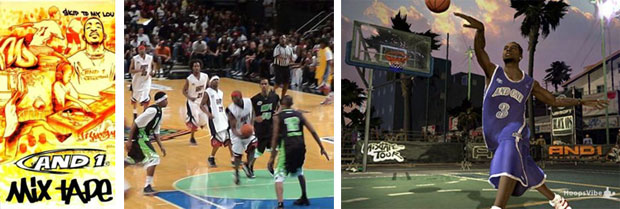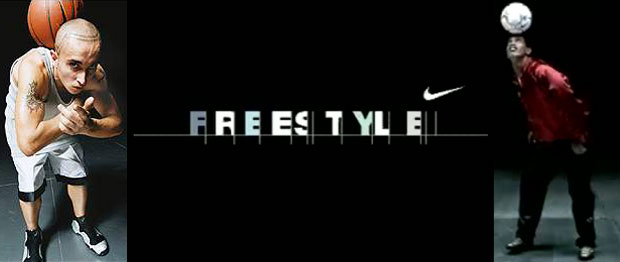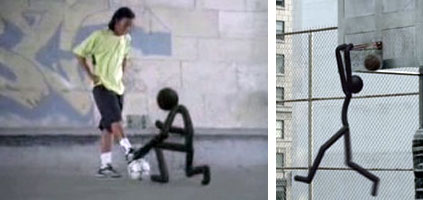Hello friends, things are still up in the air for everybody on 1UP. I hope you are keeping yourselves positive in these days and remind you that staying positive and and working hard are the best way to deal with tough times. We can stop and reflect after we have overcome. I want to keep on blogging to try to keep things interesting in the hopes that my friends don't bail on the site when it needs them the most. Today and tomorrows blogs were actually meant for the end of last year but the interview didn't happen right away so I had to postpone the blogs until now.
I wanted to talk about a merging of the cultures, in particular how street culture was accelerated through the actions of a few big companies. The trends in street culture are continuous, the era I'm talking about encompasses the past 10 years. Street culture, like any culture, borrows elements from the mainstream and underground. The music, art and style of the time are always bouncing off of each other and reforming. Where they intersect we can see some patterns emerge. Thanks to the advent of YouTube we can revisit this time and take a closer look at the culture. I will be focusing on street sports culture specifically.

The spark that ignited the modern street sports culture can be traced back to the AND 1 Mix Tape. Yes, Nike, adidas and Reebok were already a major part of street culture but AND 1 changed the paradigm in the mid-90's. The founders of AND 1 were sitting on a highlight reel of street games played at Harlem's famed Holcomb Rucker Park. In particular there was a young phenom named Rafer "Skip to My Lou" Alston stealing the show. One of their first pros that AND 1 signed suggested that they use the tape as a grassroots marketing campaign. What came of that was nothing short of a cultural revolution. The Mix Tapes were edited with the same style and ear for music that skate videos had, in essence (real) Hip Hop + sports. They were made in limited numbers and not sold in stores but rather given away by retailers for purchasing AND 1 shoes.
The buzz worked and AND 1 began to expand the tour to include stops at all of the US (and eventual world) streetball destinations. The tour became so famous that it moved off the street and into NBA arenas. Television shows and videogames soon thereafter. Turning many street stars into well-paid minor celebs. Kids learned that the NBA wasn't necessarily the place to play if your game had more style than the rules allowed. As AND 1 transformed the perception of flashy playmakers, budding pro Allen Iverson made the legendary Michael Jordan fall for his playground tricks. The mainstream noted that the street game had finally hit the big time. The NBA in its curmugeonly glory tried to stymie the street influence with rules against the crossover and even in dress codes and stricter rules on conduct on the sidelines. This was despite the NBA's own history importing legends from the playground during the golden years. Earl "the Pearl" Monroe, Kareem Abdul Jabbar and Julius "Dr. J" Earving all had playground roots. If anything the Mix Tapes, Iverson and the lot were reminding us that the sport can be both stylish and substantial.

Nike, always keen to the changing tide of street culture didn't let this go unnoticed. In late 90's they too began a campaign to show that they were aware of the growing street culture. You might remember this time better as the "Freestyle" campaign. Shot by marketing juggernaut Weiden & Kennedy and choreographed by Savion Glover with music by Afrika Bambaataa, it was a very hard to ignore campaign.
The commercial layered the details that made the AND 1 Mix Tapes successful and then built upon them. It captured the music and look of freestyle or street basketball well. The athletes weren't wearing team jerseys but instead more comfortable, realistic playing clothes. Some of the athletes were streetball legends, like Malloy "Future" Nesmith, that never made it past the college game. Luis "Trikz" DaSilva stood out in an open casting call for his fancy dribbling tricks. These streetballers and freestylers were mixed in with b-boys as well as NBA talent. Nike then went on tour with some of their freestyle talent to put on demos at stores, in malls and wherever hoop and sneaker-heads were taking their cues. This broad range of talent, and shameless name dropping, went over well for Nike and the mainstream media. The gauntlet was thrown down, anything that AND 1 could do, Nike could do better or at least in a higher profile capacity.
However on the other continents where football / soccer is more popular, the street cultures were treated to slightly different versions of the Freestyle theme. Yes they saw the basketball ads, however the soccer Freestyle campaign was even more visual. As AND 1 had signaled the changing tide and Nike put their seal on it, so to did freestyle culture grow into the mainstream consciousness. The football variations of freestyle were unique to England and Europe in that it was a way for their youth culture to express themselves and their already mad love for football. Whereas AND 1 was steamrolling Nike with progressive Mix Tape tours and videos in the US, Nike was keeping their cultural dominance more visual abroad through football. Like their short-lived Battleground tournaments for streetball, Nike launched a competitive arena game based on the Dutch obsession with panna.
A panna is when you kick a soccer ball between the legs of an opponent and catch it on the other side. It's called a nutmeg in England. The move is the ultimate humiliation move in football. The basketball equivalent would be getting an opponent to fall for a crossover. The Dutch have built a game around the move, enclosed in a small circle players try to kick the ball between their opponents legs and score a panna or kick it to a small goal on the sides. Some of the origins of the moves and freestyle tricks are said to have been based on street football and also indoor football, known better as futsal. Where names like Jermaine Vanenburg are as legendary as Skip to My Lou. What Nike did was mix the Battlegrounds theme with panna and build a cage and tournament for the top street players in Europe. In typical marketing genius Nike even made a funny documentary about the culture and contest they hosted.
The industry in Europe recognized the demand for suitable panna cage and began building and selling formal courts. Those that participated in this freestyle culture found acceptance via the media and internet. Their displays of dribbling ability and creativity were seen as less of a hobby and more of a genuine talent. As Nike had moved to find recognition within the community and change mainstream perceptions, so too did gaming juggernauts try to get their own slice of the developing culture. Most notably EA created their BIG division around the "Street" culture. The titles were never meant to compete directly with their core NFL / NBA / FIFA titles, but rather bring in those that favored non-traditional sports like Tony Hawk Pro Skateboarding. Rather than pay big-name athletes for motion capture sessions, EA scouted the best talent from the street. Youngsters that had a following from homebrew tapes, web videos and street competitions were tapped to create the mind-bending moves featured in most of the EA STREET titles. You can imagine that these athletes weren't generously rewarded for their efforts.

As the street game gained popularity the apparel makers continued featuring the athletes in ad campaigns. The follow-up to Nike's Freestyle was the lesser-known Stickman campaign.
The Stickman character was rotoscoped from the best freestylers in their respective discipline. In basketball the majority of his moves and animation were based on Luis DaSilva. In football it was the godfather of freestyle football, Mr. Woo. The Stickman would go around to various courts and challenge the playground legends to a little one-on-one. In New York he was seen playing streetball with legends Future, Bone Collector and Trikz. In a display of playground folly Nike decided to add frisbee into the mix. Those frisbee athletes are very creative but the ties between playground basketball and freestyle football culture are nonexistent. As ESPN showed their ignorance of cultures in the early years of the X Games by trying to put skateboarding and inline skating side-by-side, so too did Nike display some ignorance by putting frisbee on par with playground basketball.

Before Nike (and the mainstream) changed their attention back to professional athletes, they created a contest to find the best freestyler in the UK. Nike had been hosting tournaments there for years but now they wanted to find out for certain who was the best of them all, specifically between basketball and football. What made this contest so important was that the purpose was to declare a champion based on expressive style rather than sport. As a welcome change of pace this wouldn't be another Nike-branded gladiator battle for supremacy in a steel welded cage but rather an open contest in a b-boy format. Nike was finally recognizing the contribution of freestyle in street culture rather than using it in an advertising only capacity. By crowning a champion where no scoreboard or rules determined a winner showed that they had finally "gotten it."
So who was crowned the champion freestyler in the UK? Come back tomorrow and find out!
Were you ever into the street, or playground version of a sport? Let me know in the comments section please. As always if you would like to sponsor me please visit my Patreon page and consider donating each month, even as little as $1 would help make better blogs and even podcasts!
No comments:
Post a Comment